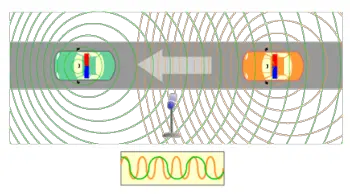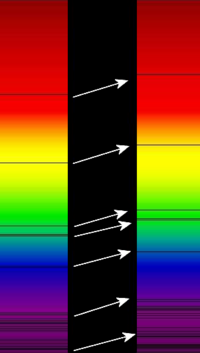Doppler effect
The Doppler effect, named after Christian Doppler, is the apparent change in frequency and wavelength of a wave that is perceived by an observer moving relative to the source of the waves. For waves, such as sound waves, that propagate in a wave medium, the velocity of the observer and the source are reckoned relative to the medium in which the waves are transmitted. The total Doppler effect may therefore result from either motion of the source or motion of the observer. Each of these effects is analyzed separately. For waves which do not require a medium, such as light or gravity in special relativity only the relative difference in velocity between the observer and the source needs to be considered.
Development
Doppler first proposed to the effect 1842 in the monograph Über das farbige Licht der Doppelsterne und einige andere Gestirne des Himmels - Versuch einer das Bradleysche Theorem als integrirenden Theil in sich schliessenden allgemeineren Theorie (On the coloured light of the binary refracted stars and other celestial bodies - Attempt of a more general theory including Bradley's theorem as an integral part) [1]. The hypothesis was tested for sound waves by the Dutch scientist Christoph Hendrik Diederik Buys Ballot in 1845. He confirmed that the sound's pitch was higher as the sound source approached him, and lower as the sound source receded from him. Hippolyte Fizeau discovered independently the same phenomenon on electromagnetic waves in 1848 (in France, the effect is sometimes called "effet Doppler-Fizeau").
General
For waves that travel through a medium (sound, ultrasound, etc...) the relationship between observed frequency f' and emitted frequency f is given by:
- where
- is the velocity of the waves (340 m/s for sound)
- is the velocity of the observer and
- is the velocity of the source (the thing emitting the sound)
For sign convention on velocity: a positive value is used if the motion is towards the other, and a negative value if the motion is away from the other.
Analysis
It is important to realize that the frequency of the sounds that the source emits does not actually change. To understand what happens, consider the following analogy. Someone throws one ball every second in a man's direction. Assume that balls travel with constant velocity. If the thrower is stationary, the man will receive one ball every second. However, if the thrower is moving towards the man, he will receive balls more frequently because the balls will be less spaced out. The converse is true if the thrower is moving away from the man. So it is actually the wavelength which is affected; as a consequence, the perceived frequency is also affected.
If the moving source is emitting waves through a medium with an actual frequency f0, then an observer stationary relative to the medium detects waves with a frequency f given by:
where v is the speed of the waves in the medium and vs, r is the speed of the source with respect to the medium (positive if moving away from the observer, negative if moving towards the observer), radial to the observer.
A similar analysis for a moving observer and a stationary source yields the observed frequency (the observer's velocity being represented as vo):
where the same convention applies : vo is positive if the observer is moving away from the source, and negative if the observer is moving towards the source.
These can be generalized into a single vector equation. Take the coordinate system to be at rest with respect to the medium, whose speed of sound is . There is a source moving with velocity and emitting waves with a frequency . There is a detector moving with velocity , and the unit vector from to is (i.e. ). Then the frequency at the detector is found from
If , then the change in frequency depends mostly on the relative velocity of the source and detector:
Or, alternatively:
The first attempt to extend Doppler's analysis to light waves was soon made by Fizeau. In fact, light waves do not require a medium to propagate and the correct understanding of the Doppler effect for light requires the use of the Special Theory of Relativity. See relativistic Doppler effect.
Applications
Everyday
The siren on a passing emergency vehicle will start out higher than its stationary pitch, slide down as it passes, and continue lower than its stationary pitch as it recedes from the observer. Astronomer John Dobson explained the effect thus:
- "The reason the siren slides is because it doesn't hit you."
In other words, if the siren approached the observer directly, the pitch would remain constant (as vs, r is only the radial component) until the vehicle hit him, and then immediately jump to a new lower pitch. The difference between the higher pitch and rest pitch would be the same as the lower pitch and rest pitch. Because the vehicle passes by the observer, the radial velocity does not remain constant, but instead varies as a function of the angle between his line of sight and the siren's velocity:
where vs is the velocity of the object (source of waves) with respect to the medium, and is the angle between the object's forward velocity and the line of sight from the object to the observer.
Astronomy
The Doppler effect for electromagnetic waves such as light, is of great use in astronomy, and results in either a so-called redshift or blueshift. It has been used to measure the speed at which stars and galaxies are approaching toward or receding from us, that is, the radial velocity. This is used to detect if a single star is, in fact, a close binary and even to measure the speed of rotation of stars and galaxies.
The use of the Doppler effect for light in astronomy depends on the fact that the spectra of stars are not continuous. They show absorption lines at well defined frequencies that are correlated with the energies required to excite electrons in various elements from one level to another. The Doppler effect is recognizable in the fact that the absorption lines are not always at the frequencies that are obtained from the spectrum of a stationary light source. Since blue light has a higher frequency than red light, the spectral lines from an approaching astronomical light source show a blueshift and those of receding sources show a redshift.
Among the nearby stars, the largest radial velocities with respect to the Sun are +308 km/s (BD-15°4041, also known as LHS 52, 81.7 light-years away) and -260 km/s (Woolley 9722, also known as Wolf 1106 and LHS 64, 78.2 light-years away). Positive radial velocity means the star is receding from the Sun, negative that it is approaching.
Temperature measurement
Another use of the Doppler effect which is found mostly in astronomy, is the estimation of the temperature of a gas which is emitting a spectral line. Due to the thermal motion of the gas, each emitter can be slightly red or blue shifted, and the net effect is a broadening of the line. This line shape is called a Doppler profile and the width of the line is proportional to the square root of the temperature of the gas, allowing the Doppler-broadened line to be used to measure the temperature of the emitting gas.
Radar
Main article: Doppler radar
The Doppler effect is also used in some forms of radar to measure the velocity of detected objects. A radar beam is fired at a moving target - a car, for example, as radar is often used by police to detect speeding motorists - as it recedes from the radar source. Each successive wave has to travel further to reach the car, before being reflected and re-detected near the source. As each wave has to move further, the gap between each wave increases, increasing the wavelength. In some situations, the radar beam is fired at the moving car as it approaches, in which case each successive wave travels a lesser distance, decreasing the wavelength. In either situation, calculations from the Doppler effect accurately determine the car's velocity.
The Proximity fuze which was developed during World War II also relies on Doppler radar.
Medical imaging and blood flow measurement
An echocardiogram can, within certain limits, produce accurate assessment of the direction of blood flow and the velocity of blood and cardiac tissue at any arbitrary point using the doppler effect. One of the limitations is that the ultrasound beam should be as parallel to the blood flow as possible. Velocity measurements allow assessment of cardiac valve areas and function, any abnormal communications between the left and right side of the heart, any leaking of blood through the valves (valvular regurgitation), and calculation of the cardiac output. Contrast-enhanced ultrasound using gas-filled microbubble contrast media can be used to improve velocity or other flow-related medical measurements.
Although "Doppler" has become synonymous with "velocity measurement" in medical imaging, in many cases it is not the frequency shift (Doppler shift) of the received signal that is measured, but the phase shift (when the received signal arrives).
Velocity measurements of blood flow are also used in other fields of medical ultrasonography, such as obstetric ultrasonography and neurology. Velocity measurement of blood flow in arteries and veins based on doppler effect is an effective tool for diagnosis of vascular problems like stenosis[2].
Flow measurement
Instruments such as the laser Doppler velocimeter (LDV), and Acoustic Doppler Velocimeter (ADV) have been developed to measure velocities in a fluid flow. The LDV and ADV emit a light or acoustic beam, and measure the doppler shift in wavelengths of reflections from particles moving with the flow. This technique allows non-intrusive flow measurements, at high precision and high frequency.
See also
- Relativistic Doppler effect
- Doppler broadening
- Fading and Rayleigh fading, discussing doppler spread of radio signals
ReferencesISBN links support NWE through referral fees
External links
ar:تأثير دوبلر bs:Dopplerov efekt bg:Доплеров ефект ca:Efecte Doppler cs:Dopplerův jev da:Dopplereffekt de:Doppler-Effekt et:Doppleri efekt es:Efecto Doppler eo:Efiko Doppler fr:Effet Doppler-Fizeau hr:Dopplerov efekt id:Efek Doppler it:Effetto Doppler he:אפקט דופלר lv:Doplera efekts hu:Doppler-effektus nl:Dopplereffect ja:ドップラー効果 no:Dopplereffekten nn:Dopplereffekten pl:Efekt Dopplera pt:Efeito Doppler ro:Efectul Doppler ru:Эффект Доплера sk:Dopplerov jav sl:Dopplerjev pojav sr:Доплеров ефекат sh:Doplerov efekat fi:Doppler-ilmiö sv:Dopplereffekt vi:Hiệu ứng Doppler tr:Doppler Etkisi zh:多普勒效应























